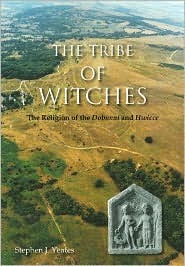The Tribe of Witches facts for kids

The first edition cover of the book, depicting Cleeve Hill in the background, with a relief of Mercury and his consort found in Gloucester in the foreground.
|
|
| Author | Stephen J. Yeates |
|---|---|
| Country | England |
| Language | English |
| Subject | English Iron Age archaeology, Anglo-Saxon archaeology |
| Publisher | Oxbow Books |
|
Publication date
|
2008 |
| Media type | Print (Paperback) |
| Pages | 195 |
| ISBN | 978-1842173190 |
| Followed by | A Dreaming for the Witches (2009) |
The Tribe of Witches: The Religion of the Dobunni and Hwicce is a historical and archaeological study of pre-Christian religion among the Iron Age Dobunni and the Early Medieval Hwicce, two tribal groups who lived in central England. It was written by the archaeologist Stephen J. Yeates and published by Oxbow Books in 2008. Yeates had previously published his theories in a three-volume British Archaeological Report monograph entitled Religion, Community and Territory: Defining Religion in the Severn Valley and Adjacent Hills from the Iron Age to the Early Medieval Period (2006).
Throughout the book, Yeates explores a number of different archaeological and geographical features located in the region of Dobunni and Hwicce, looking at how the landscape evolved throughout the Iron Age, Romano-British period and Early Middle Ages. These include the temples built in the area, sacred rivers, mines and defensive features.
The Tribe of Witches was reviewed in both peer-reviewed academic journals and by a number of practicing Pagans. The former were predominantly negative, arguing that Yeates' arguments were farfetched, lacking sufficient evidence and that he suffered from a poor grasp of onomastics; in contrast, many also praised his writing style and his extensive use of references and images. Yeates expanded on the theories put forward in The Tribe of Witches in his later book, A Dreaming for the Witches: The Recreation of the Dobunni Primal Myth (2009).
Background
The book was the result of research carried out by Yeates at Oxford University as part of a D.Phil. project from 2001–05. The supervisors of the study were Prof. Martin Henig and Prof. Barry Cunliffe, and the assessors Dr. Ray Howell and Prof. Chris Gosden. Though certain ideas, such as that concerning Cuda, had already been formulated before this period.
Several of Yeates' arguments and theories had seen publication prior to the release of The Tribe of Witches. His theories regarding the goddess Cuda had been published in peer assessed academic journals both locally, and internationally. A review of the 2006 publication Religion, Community, and Territory from a linguist Baker stated that we should now recognise Cuda and that she is the root of place-names using *Cod. Some of the Cotswold river-names have been discussed in an article in the Journal of the English Place-name Society. His arguments for cultural continuity in the region were also published in a peer assessed paper in Lewis and Semple (2010) Perspectives in Landscape Archaeology: Papers presented at Oxford 2003–05.
Synopsis
Chapter one, "The Dobunni, the Hwicce and Religion", offers an introduction to Yeates' argument, noting that his study is multidisciplinary in nature, making use of history, archaeology and onomastics. Offering a brief background to both the Dobunni and the Hwicce, Yeates then briefly discusses the manner in which scholars have previously approached the study of pre-Christian religion in Britain. The second chapter, entitled "The Deity and the Landscape", looks at the various shrines and temples from both the Pre-Roman and Roman Iron Age that have been archaeologically identified within the Dobunni region. Using etymological evidence, he puts forward propositions for the existence of previously unknown prehistoric deities who were localised to the region, namely an Iron Age goddess of the Cotswolds known as Cuda. Yeates attempts to present a picture of the regional landscape, and the manner in which it was viewed as being "spiritual and imbued with the divine" by its inhabitants.
Chapter three, "The Sacred Rivers", explores the deification of rivers in the British Iron Age, and the archaeological evidence for votive offerings within them. Yeates proceeds to look at the multiple rivers within the region being discussed – including the River Severn and River Wye – while making reference to any evidence for ritual activity along them. The fourth chapter, "The Gods of Tribes and Folk Groups", considers the long-term developments of communities in the area, and the connections that might exist between Iron Age and Early Medieval settlements. Proclaiming that Medieval sources record the existence of two local Iron Age gods, Weogonera and Salenses, he uses this as evidence for his belief that there was a cultural continuity from prehistory into the Medieval, and that the Hwicce were therefore the descendants of the Dobunni. Chapter five, "Mining and Minerals", explores evidence for mining in the region, highlighting the connection between this activity and religious belief in prehistoric society. Chapter six deals with aspects of war.
Chapter seven deals with the local hunter god and sacred groves or nemetons. Arguments concerning the hunter god in local "Dobunnic" religion are not new and have their origins in a series of publications by Boon, Henig and Merrifield. Chapter eight looks at tree shrines. Chapter nine the significance of burial in the landscape. Chapter ten considers the sacred horse. Chapter eleven looks at the tribal deities. Chapter twelve the influence of Christianity.

